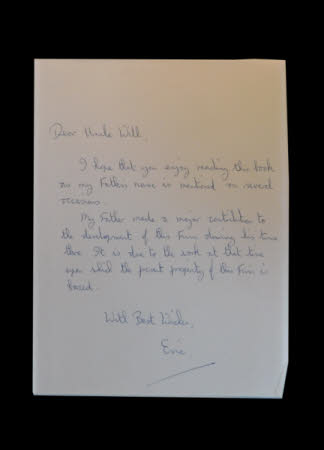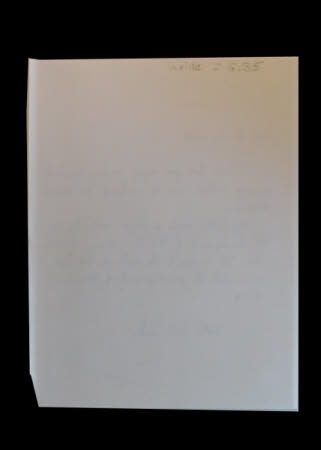Letter
Category
Ephemera
Date
Unknown
Materials
Paper
Order this imageCollection
Mr Straw's House, Nottinghamshire
NT 3168372.2
Summary
Handwritten letter on white paper. 'Dear Uncle Will, I hope that you enjoy reading this book as my fathers name is mentioned in several sections. My father made a major contribution to the development of this fro sharing his time there. It is due to the work at that time upon which the present prosperity of this firm is faced. With Best Wishes Eric.' The back is blank. The letter is kept in the book 'Through a glass clearly' by Alec W. Clark (record 3168372). Beaston Clark Glass Manufacturers, from about 1751 John Wright was in business at Masbrough in partnership with others. The site of the glassworks was on land belonging to the Earl of Effingham alongside the canal. This meant that coal for the melt as well as the finished products could be cheaply and easily transported. There were two glass houses; one for crown window glass and the other a bottle and flint house. In 1783 the business was owned by William Beatson, and in various partnerships existed as a family business. In 1837 John and William Beatson are also recorded as dealing in chemicals (vitriol, soda ash, chloride of lime, &c). Later the company was called Beatson, Clark and Co. Ltd, which became a public company in 1961. The family connection has now ceased. The company produced a wide variety of bottles and jars together with some very strange articles like cupping glasses, dutch drops, drawer knobs, feeding bottles, confectioners' jars and antiguglars. By the 1860s Beatsons were operating three kilns, one for bottle glass and two for flint glass and had acquired a reputation for fine pharmaceutical glassware. The last glass cone was demolished in 1945. Glass was last hand-blown at Beatson Clark's about 1954, after which the machines ftook over. The single gob and double gob machines for produced bottles, and the lehrs on which the bottles were proved before passing to the checkers, who rejected anything with defects which ended up as cullet (broken glass used in the flux). Beatsons are major suppliers of glass containers to the cosmetic, pharmaceutical and chemical industries, most commonly brown glass medicine bottles. These are known as 'Roche Rounds' as they were originally produced for the pharmaceutical company Hoffman La Roche. The Beatson sign on the bottom of their products is a double headed arrow. Dr. Alec Clark, who was Executive Chairman of the Company, was also elected Master of the Worshipful Company of Glass Sellers in 1969. He also wrote a book "Though a Glass Clearly". Beatson Clark is now part of the Newship Group the last glass manufacturer still operating in the Borough of Rotherham.

